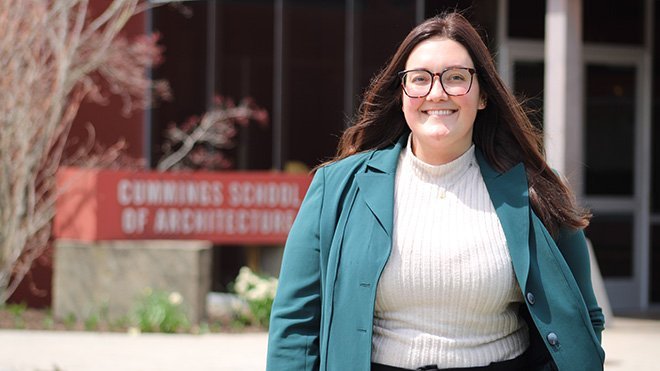Master in Architecture Graduate Creates Solutions, Builds Connections
During her time at RWU, Renee Parry has participated in hands-on studio projects, studied Preservation Practices, and worked as a designer for Tecton Architects.

BRISTOL, R.I. – When she started college, Renee Parry majored in art and pictured herself in a career as an illustrator. But she soon realized that while she loved the creative nature of the art major, she yearned for a more technical field. Since she was 16, Parry also had worked on construction sites with her father, a general contractor near where she grew up in Schaghticoke, N.Y. As she poured concrete and helped with carpentry, she said she appreciated seeing the work her father’s company did overseeing projects.
“Architecture fell directly into that happy medium between the creativity and also the technical application of construction practices, math, and science,” said Parry, who is graduating with a Master of Architecture degree and a Certificate in Preservation Practices from Roger Williams University. “I love calculus, and I absolutely loved physics, so for me, having that balance of both of them, architecture is literally the happy medium, where all these disciplines are combined and fall into place.”
Parry, who has a B.S. in architectural design and technology from the University of Hartford, said she has applied her combination of creativity and technical skills to projects in the classroom and beyond during her time at RWU. For example, one of her first classes was the Graduate Architectural Design Studio. Students in the class learned directly from architects in the Boston office of architectural firm Perkins & Will. She said her group worked on ideas for the revitalization of Boston’s Long Island, a city-owned island in the Boston Harbor that is the home of a number of historic sites.
“[It] opened my eyes to how much more I could do as a designer,” Parry said. “That was probably the first studio I’ve ever had throughout my entire academic career where I’ve ever been pushed beyond the bounds of what I even knew I was capable of. It was amazing.”
RWU’s Preservation Practices program is a major part of why Parry chose the university, she said. She recognizes the tension that sometimes exists between preservation of older properties and the need for new housing, but said, “preservation doesn’t need to stop affordable housing. Even though we have these beautiful historic sites, which are very well protected, there’s still a housing crisis, there are still people that need homes, and there are still needs for shelter and living.”
In the design studio and other courses, she said she enjoyed thinking about creative ways to preserve the integrity of historic structures while still providing housing solutions.
Throughout most of the program, Parry also worked part-time as a designer for Tecton Architects in Hartford, Conn. Among other projects, she worked with the Root Center for Advanced Recovery, a rehabilitation facility, on a memorial garden in honor of individuals who have lost their lives to substance abuse.
Despite her rigorous schedule, Parry also served in several roles in the Graduate Student Association, most recently as president, where she organized gatherings from brewery visits to career-focused events and said she enjoyed meeting students in other graduate programs.
While Parry works toward the 3,000 required hours of experience to qualify for the architecture licensing exam, she said she’s considering several options for after graduation.
She is also a recipient of the President’s Core Values Medallion and said this recognition “means a lot to me because it highlights some of a brief synopsis of who I am and what I’ve done.” In construction, a capstone is defined as “a finishing stone of a structure.” The medallion, awarded to graduating students who best exemplify the core values of the university, is a fitting capstone for Parry’s time at RWU.
2024 Graduate Blog